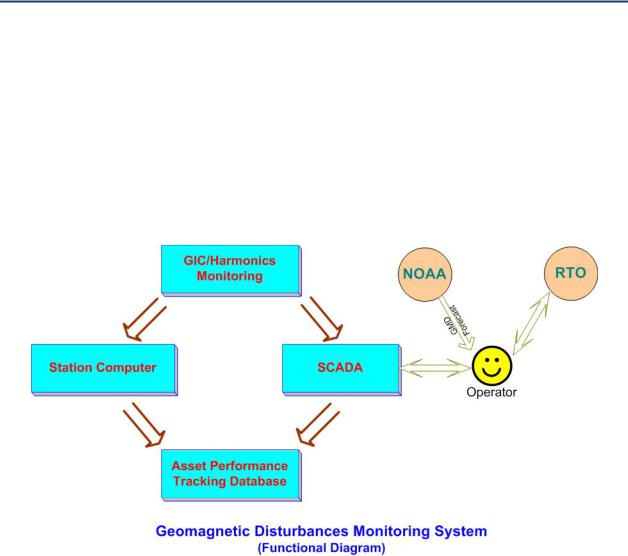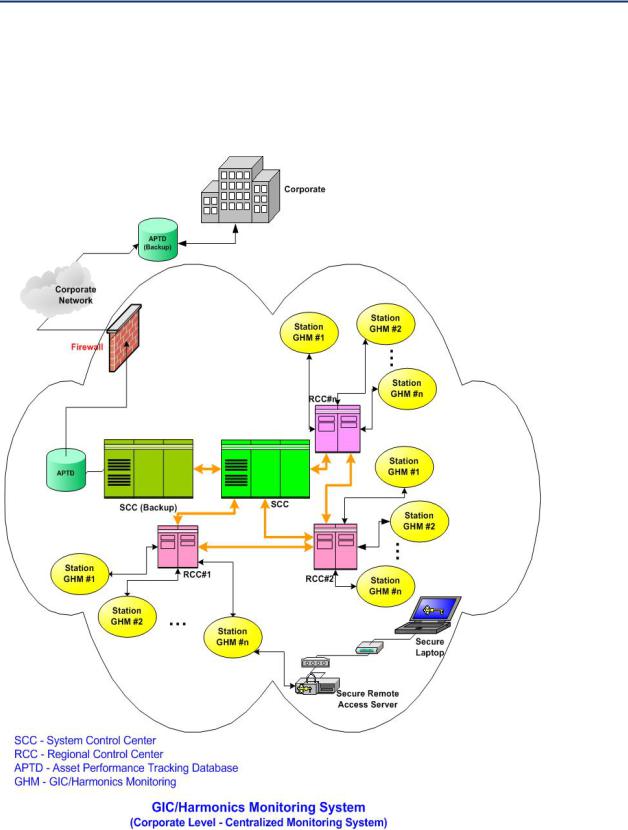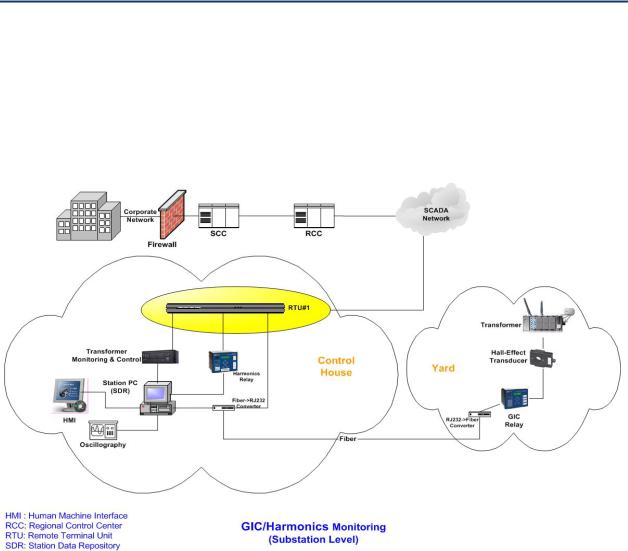
Geomagnetic_Disturbance_Task_Force_2012
.pdf
Attachment 2–April 2011 NOAA SWPC Workshop
•The electric power industry intends to address modeling the GIC that will result from the estimates of the electric field strengths that impact earth provided by Space Weather experts.
•The ability to now cast or forecast the auroral electrojets in terms of location, direction, propagation, duration, amplitude was identified as potentially useful information.
•Kp, K, or general geomagnetic indices have several limitations.
Ks are measured at a limited number of fixed locations. They also do not contain any directional information. There is a concern that for some utilities the fixed locations aren’t close enough to the operating location to provide a good measure of the disturbance level. Local Ks are scaled when contributing to Kp. Thus, a K value at low latitudes will indicate a smaller magnetic field variation than a K at high latitudes. This suggests that alternative measures should be explored (such as range or standard deviation).
There is a concern about K and Kp saturation at 9. There appeared to be a consensus among participants of the need to provide measures that would provide greater distinction between different types of disturbances that would currently (today) all be classified as K=9 or Kp=9. (For example, one could consider extending the K9 scale to add K10, K11, etc.). Today, all the conditions of moderate to extreme electric system impact are contained in the K/Kp=9. It was understood that these would likely have to be general categorizations (small, medium, large, extreme, the “big one”).
Clarification was provided by SWPC that Ks are updated minute by minute and alerts sent out within a minute of the K threshold crossing. SWPC does not wait until the end of the three hour period to issue the alert.
In spite of the limitations, the utilities stated that from the perspective of current operating practices they can generally work with Kp. The more critical issue, however, is providing reliable, advance warning of the most severe geomagnetic storms.
A key operations planning and system design issue is accurately determining the severity of a reference 1 in 100 year storm. In addition, in light of recent examples of events well in excess of what the grid can withstand (i.e., an outage or equipment damage), we need to estimate the most severe storms we could experience. There are two parts to this issue. First, how strong can the strongest possible storm be? Secondly, what is the probability for the strongest storms? For example, is the Carrington event a one in 100 year storm or a one in 1000 year storm? It would be useful for there to be a catalog of all storms which includes a measure of their intensity and duration.
Closely related to this is the need for planning and preparation based on realistic scenarios. There is a requirement to run simulations and develop optimal mitigation strategies.
There was a request for a GIC data repository to validate models from some members of the research community.
99 |
GMDTF Interim Report: Affects of Geomagnetic Disturbances on the Bulk Power System–February 2012 |

Attachment 2–April 2011 NOAA SWPC Workshop
Of concern: there is not reliable back up to the satellites we depend on for forecasting potentially harmful geomagnetic storms in the short period before an event (e.g., ACE and SOHO coronagraphs). It is also a concern that there do not appear to be funded projects to replace or improve this critical information.
A2.3 Follow-on Efforts from April 2011 NOAA SWPC GMD Workshop
SWPC carefully evaluated the feedback and discussions with grid experts and have agreed to undertake the following efforts:
•SWPC and partners will look into calculating the actual electric field strength and direction. This will require a partnership with USGS, the Community Coordinated Modeling Center (CCMC), and others. SWPC and partners will investigate ways to add more real time ground magnetometer stations and to model ground conductivity.
•It is likely that forecasts of dB/dt and the electric field will be very difficult. Therefore, forecasts of Kp, K, or alternate summary measures will be necessary for the near term. It is possible to provide climatology for dB/dt, range, standard deviation, local electric field, for a given activity level and this was identified as a useful service. SWPC will work with partners to carry out this analysis and make such climatology tables available.
•SWPC and partners will investigate alternate measures to local K indices. The goal will be to have summary measures that extend the disturbance scale up to larger values to avoid saturation, and to have summary measures that can be compared in a meaningful way. Examples include, range, standard deviation, delta B, and so on, all which are quantities that would be expressed in standard units (nT).
•SWPC and partners will also investigate a “storm catalog” and will study better ways to characterize the envelope of these disturbances. This effort will address the requirement to characterize the intensity and duration of the disturbances.
•The results of these evaluations will lead to an interagency effort to produce new, more useful real time and forecast services for the utilities.
•SWPC will coordinate with the NERC on an option for a teleconference with Reliability Coordinators in the event of an exceptional space weather situation (e.g., October 28 29, 2003). Thresholds, quantitative measures, and response procedures need to be addressed.
•SWPC will explore partnering with international partners, particularly NR Canada and the British Geological Survey (BGS), on the development and improvement of geomagnetic storm services. Mechanisms in place to facilitate these efforts include participating with NERC on the GMD task force, where NOAA and NR Canada are leads on operational services to the grid; and the recently signed MOU between NOAA/NWS and the UK Met Office, who are collaborating closely with BGS on the development of space weather services.
•SWPC representatives in the GMDTF will pursue a process for information sharing during and after geomagnetic disturbances. Feedback on system effects and impacts due to geomagnetic disturbances would be very valuable to SWPC for warning
GMDTF Interim Report: Affects of Geomagnetic Disturbances on the Bulk Power System–February 2012 |
100 |

Attachment 2–April 2011 NOAA SWPC Workshop
validation and for our modeling and research community for validation and verification of models.
In addition to the GIC and power grid focused initiatives mentioned above, SWPC are undertaking several other initiatives that will benefit the space weather user community as a whole. They include:
ACE Replacement SWPC will continue working with its government partners on a replacement for the ACE spacecraft. NOAA leadership is fully supportive of this effort and recognizes the importance of these observations in support of critical infrastructure protection. Solutions have been identified, and various activities are underway to fill this potential gap.
High Activity Response Team – SWPC are in the final stage of introducing a High Activity Response Team (HART) that can be activated during busy periods of severe space weather. HART is composed of SWPC staff, from outside of the Operations Center, who has knowledge of space weather impacts and customer effects. HART will deal with media, stakeholder and special customer inquiries during severe outbreaks of space weather. Interactions with NERC and the Reliability Coordinators are considered a critical element in this plan.
Space Weather Prediction Test bed – The effective and efficient transition of research caliber numerical space weather forecast models into operations is a critical objective for SWPC to achieve in order to ensure the future sustainment and growth of its portfolio of services. To this end, SWPC is in the process of standing up the Space Weather Prediction Test bed (SWPT) to facilitate the transition to operations of select community research models. Enlil, a solar wind disturbance propagation model, will be the first project to move through the SWPT. Enlil has the potential to accurately predict the trajectories of solar coronal mass ejections (CME) between the solar corona and the orbit of Earth and beyond.
While the SWPT is working on Enlil, the SWPC staff is working with CCMC to evaluate the relative performance characteristics of a variety of magnetosphere models. Based on the evaluation, SWPC will determine which (if any) magnetosphere models should be selected for transition to operations.
Global Model – SWPC is working with the UK Met Office on the development of the world’s first combined space weather/terrestrial weather model. This is essentially adding the physics of the thermosphere, mesosphere, and ionosphere to the UK Met terrestrial weather model. This coupled, whole atmosphere approach will improve both terrestrial and space weather forecasting.
101 |
GMDTF Interim Report: Affects of Geomagnetic Disturbances on the Bulk Power System–February 2012 |

Attachment 3–NERC Industry Advisory
Attachment 3: NERC Industry Advisory
A3.1 Introduction
This attachment contains a portion of the text of the NERC Industry Advisory on Preparing for Geo Magnetic Storms, issued on May 10, 2011. For the complete text of the Advisory, see http://www.nerc.com/fileUploads/File/Events%20Analysis/A 2011 05 10 01_GMD_FINAL.pdf.
A3.2 Operations Planning Actions
Operational planning actions are considered by the Reliability Coordinator after a severe GMD event (K>6) is predicted by NOAA or STDC, or when GIC activity measured by monitoring equipment reaches pre determined levels. All activities are meant to pre position the bulk power system GMD effects that are experienced on real time operations:
Increase import capability
o Discontinue non critical maintenance work and restore out of service transmission lines, wherever possible.
oEvaluate postponing or rescheduling planned outage and maintenance activities. Avoid taking transmission lines out of service unless to interrupt a major path of GIC and the bulk power system reliability impact of the line outage has been evaluated.
The Reliability Coordinator may instruct Generator Operators to increase real and reactive reserves to preserve system integrity during a strong GMD event by performing such actions as:
oReducing generator loading.
o Evaluate generator re dispatch mix to implement.
oBringing equipment on line that is capable of providing reactive power, such as generators, synchronous condensers, static VAr compensators, etc.
Transmission Operators and Generator Operators should increase attention to situation awareness and enhance surveillance procedures. Reliability Coordinators should be informed of all actions such as:
oUnusual voltage and/or MVAr variations and unusual temperature rise are detected on transformers and GSU’s.
oAbnormal noise and increased dissolved gas on transformers, where monitoring capability exists.
oTrips by protection or unusual faults that are detected in shunt capacitor banks and static VAr compensators
GMDTF Interim Report: Affects of Geomagnetic Disturbances on the Bulk Power System–February 2012 |
102 |

Attachment 3–NERC Industry Advisory
A3.3 Real-Time Operations Actions
The aforementioned operator actions are coordinated with the Reliability Coordinator when a severe GMD warning (K>6) is issued, prior to the detection of increased base line GIC levels (which are 30 to 60 minutes prior to storm impact). During real time operation, actions that increase reactive reserves and decrease loading on susceptible equipment can help provide additional margin for reliability. In order to secure this reactive support, coordinating with their Reliability Coordinators, operators can take actions such as:
Bringing equipment online to provide additional reactive power reserves.
Increasing dynamic reactive reserves by adjustment of voltage schedules or other methods.
Reducing power transfers to increase available transfer capability and system reactive power reserves.
Decreasing loading on susceptible transformers through reconfiguration of transmission and re dispatching of generation.
Further, operations should increase their attention to situation awareness and coordinate information and actions with Reliability Coordinator such as:
Reducing power output at susceptible generator stations if erratic reactive power output from generators or excess reactive power consumption by generator step up transformers is detected.
Removing transmission equipment from service if excessive GIC is measured or unusual equipment behavior is experienced and the system impact of the equipment outage has been evaluated.
Operator actions are coordinated with the Reliability Coordinator after receiving a severe GMD warning (K>6), prior to the detection of increased baseline GIC levels (30 to 60 minutes prior to storm impact.
103 |
GMDTF Interim Report: Affects of Geomagnetic Disturbances on the Bulk Power System–February 2012 |

Attachment 4–Current GMD Response Procedures
Attachment 4: Public GMD Response Procedures
ISO-New England
System Operating Procedures – SOP RTMKTS.0120.0050
Implement Solar Magnetic Disturbance Remedial Action
Effective: February 4, 2011 http://www.iso ne.com/rules_proceds/operating/sysop/rt_mkts/sop_rtmkts_0120_0050.pdf
MISO
Geo Magnetic Disturbance Procedure – RTO OP 053 r5 Effective: December 20, 2011
https://www.midwestiso.org/Library/Repository/Procedure/RTO OP 053 r5%20Geomagnetic%20Disturbance%20Procedure.pdf
NYISO
Transmission and Dispatching Operation Manual Section 4.2.11 – Solar Magnetic Disturbances Effective: September 4, 2008
http://www.nyiso.com/public/webdocs/documents/manuals/operations/trans_disp.pdf
Northeast Power Coordinating Council
Procedures for Solar Magnetic Disturbances Which Affect Electric Power Systems Effective: January 11, 2007 https://www.npcc.org/Standards/Procedures/c 15.pdf
PJM
PJM Manual 13 – Emergency Operations
Section 3.7 – Geo Magnetic Disturbances
Effective Date: January 1, 2012
http://www.pjm.com/~/media/documents/manuals/m13.ashx
GMDTF Interim Report: Affects of Geomagnetic Disturbances on the Bulk Power System–February 2012 |
104 |

Attachment 5–OEM Documents
Attachment 5: Public OEM Documentation on GMD
Schweitzer Engineering Laboratories
Geomagnetically Induced Currents: Detection, Protection, and Mitigation
Document: AG2011 16
This Schweitzer Engineering Laboratories application guide shows:
•How GIC can impact your power system.
•How to detect GMD events using equipment you already have installed.
•How SEL relays respond to GMD events, which relay settings are relevant to GIC, and how to make sure you have the best settings for both normal and geomagnetic storm power system conditions.
•How to collect and display GIC information and develop coordinated system responses to these conditions.
Authors: Greg Zweigle, Jeff Pope, and David Whitehead
Published: 10/11/2011
http://www.selinc.com/WorkArea/DownloadAsset.aspx?id=98310
105 |
GMDTF Interim Report: Affects of Geomagnetic Disturbances on the Bulk Power System–February 2012 |

Attachment 6–Monitoring and Measurement Architecture
Attachment 6: Monitoring and Measurement
Architecture
A6.1 Introduction
This attachment provides an example of a monitoring and measurement architecture an organization could consider. The functional diagram of a GIC/Harmonics Monitoring (GHM) system is represented below in Figure A6 1.
Figure A6 1: Functional diagram of GIC/Harmonics monitoring system
A6.2 GIC/Harmonics Monitoring (GHM) System – Corporate Level
The GIC/Harmonics Monitoring (GHM) System may comprise a System Control Center (SCC), a few Regional Control Centers (RCCs), and a number of GIC/Harmonics Monitoring (GHM) networks located at key substations. Figure A6 2 demonstrates the configuration of a GIC/Harmonics Monitoring (GHM) System. The number of Regional Control Centers depends on a utility’s geographical service territories and practice, etc. The Asset Performance Tracking Database (APTD) normally can be located at the system control center, and connected to the backup server of SCC to minimize interventions to other key functions of the SCC, such as monitoring and control functions. The APTD may be accessed by authorized users from the corporate WAN. Internal firewalls and a secure router between the corporate wide area network (WAN) and the SCC are used to secure the GHM SCADA network.
The connection between a substation and the regional control center should ensure the transmission of real time monitoring data with first priority. Other non time critical data, such as event logs and oscillography data will be stored at local substation computer and can be polled regularly by the APTD.
GMDTF Interim Report: Affects of Geomagnetic Disturbances on the Bulk Power System–February 2012 |
106 |

Attachment 6–Monitoring and Measurement Architecture
The RCC is responsible for monitoring critical asset. If a monitored transformer at a station is in an abnormal condition and its GIC exceeds a preset threshold, an alarm signal will display on a monitor at the RCC to alert the operator.
Figure A6 2: GIC/Harmonics Monitoring (GHM) system – corporate level
107 |
GMDTF Interim Report: Affects of Geomagnetic Disturbances on the Bulk Power System–February 2012 |

Attachment 6–Monitoring and Measurement Architecture
A6.3 GIC/Harmonics Monitoring (GHM) System – Substation Level
Figure A6 3 shows a typical GHM configuration at substation level. If a substation network is identified as Critical Cyber Assets per NERC CIP Standards, serial to fiber converters such as RMC20s can be used in the GIC cabinet and at the RTU panel to provide serial connection over fiber.
Figure A6 3: GIC/Harmonics Monitoring (GHM) System – substation level
GMDTF Interim Report: Affects of Geomagnetic Disturbances on the Bulk Power System–February 2012 |
108 |
